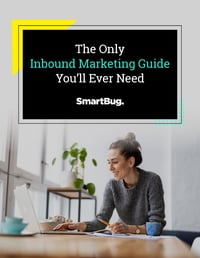
You’ve probably heard the term “inbound marketing” more than a few times since it first appeared on the marketing scene in 2005. But if you aren’t already creating inbound marketing campaigns, you might be wondering how much of a difference creating a company blog or posting on social media could make to your ROI.
If so, you’ve come to the right place! Let’s break down how inbound marketing actually works, the stats on exactly how well it works (hint: extremely well), and how you can take the first step into creating your inbound marketing strategy today.
What Is Inbound Marketing?
If you’re not familiar with inbound marketing, here’s a quick rundown.
Inbound marketing focuses on three stages of engagement with your customers: attract, engage, and delight. The combination of these stages is known as the inbound marketing flywheel.
First, your marketing efforts in the attract stage draw in potential customers and establish trust that your brand is an authority.
Then, you present valuable insights in the engage stage that show how your product or service can solve the problems of those potential customers.
Finally, you provide support in the delight stage, ensuring customers are happy with their purchases. In turn, those happy customers help your business grow through reviews and recommendations.
How Does Inbound Marketing Work?
Inbound marketing works by attracting the right kind of traffic.
Rather than interrupting your customers by throwing ads and cold sales calls at them and hoping for the best, inbound marketing focuses on creating content that is valuable for your target market—so valuable that they seek it out all on their own.
Whether you’re looking into inbound marketing for B2B or B2C, audiences of all kinds prefer to do their own research before diving into any product or service. In fact, 53 percent of shoppers say they always do research before they buy to ensure they are making the best possible choice.
With inbound marketing, you’re creating a well of valuable information on the pain points you solve, so those curious shoppers find your company in their research. Once they do, they’ll find all the other valuable content you’ve been building and continue their research with you, soon learning that your company is a trusted source. When they’re ready to buy, they’ll remember who they trust to solve their problems: you.
Does Inbound Marketing Really Work?
Not only is inbound marketing more effective than traditional outbound marketing, but it can also save you money:
- Inbound marketing generates more leads than outbound—as much as 126 percent more.
- Leads generated through inbound marketing have a higher chance of converting—leads gained through SEO have a close rate of 14.6 percent. Compare that to outbound’s 1.7 percent close rate!
- Inbound marketing is cheaper. According to HubSpot, the cost for lead acquisition for inbound marketing is at least 67 percent less than outbound.
So if you’re ready to save money, generate more leads, and improve your close rate, it’s time to get started with inbound marketing.
How to Start Inbound Marketing
A great place to start is a marketing audit. Take a look at all your marketing efforts and put them into either the attract, engage, or delight bucket.
Here are some examples of what could fall into each bucket:
- Attract: Blogs, downloadable content offers, social media
- Engage: Email newsletters, case studies
- Delight: Surveys, knowledge bases, loyalty programs
Is there a bucket that feels a little empty compared to the others? Start by filling that one up so your flywheel spins a little more evenly.
The next step is to look at each of your offerings in each of these buckets and think about how they’re adding value to your customers and how you can provide more.
How to Keep Inbound Marketing Running
Once you have your inbound marketing flywheel spinning, you also have to keep an eye out for friction—poor internal processes, lack of communication between departments, and unmet customer pain points throughout your sales process can all slow your flywheel down.
Take a look at where prospects are dropping out of your sales journey and see what you can do to make that step easier. Maybe there’s one too many sales calls in the process or a missed opportunity to send an automated email to an interested customer while they’re at their most invested.
Once you’ve mastered these first steps, you’re ready to dive into The Only Inbound Marketing Guide You'll Ever Need—it’s packed with specific inbound marketing strategies to try and more.

About the author
Lauren Nettles is a Senior Account Specialist at SmartBug Media—an expert at all things inbound marketing. She has a wide range of content, copy, and marketing strategy experience, from small local businesses to huge gaming companies and international publishing houses. At SmartBug, her focus is on empowering clients with the results, knowledge, content, data, and tools to make their business the best it can be. Read more articles by Lauren Nettles.









